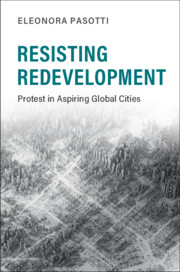Book contents
- Resisting Redevelopment
- Cambridge Studies in Contentious Politics
- Resisting Redevelopment
- Copyright page
- Dedication
- Contents
- Illustrations
- Acknowledgments
- Part I Setting the Comparison
- Part II Explaining Mobilization
- 5 Experiential Tools and Networks
- 6 Squatting, Experiential Tools, and Protest Legacies
- 7 Judicial Resistance, Experiential Tools, and Protest Legacies
- 8 Protest with High Union Support
- Part III Explaining Impact
- Book part
- Bibliography
- Index
- Cambridge Studies in Contentious Politics
6 - Squatting, Experiential Tools, and Protest Legacies
from Part II - Explaining Mobilization
Published online by Cambridge University Press: 09 March 2020
- Resisting Redevelopment
- Cambridge Studies in Contentious Politics
- Resisting Redevelopment
- Copyright page
- Dedication
- Contents
- Illustrations
- Acknowledgments
- Part I Setting the Comparison
- Part II Explaining Mobilization
- 5 Experiential Tools and Networks
- 6 Squatting, Experiential Tools, and Protest Legacies
- 7 Judicial Resistance, Experiential Tools, and Protest Legacies
- 8 Protest with High Union Support
- Part III Explaining Impact
- Book part
- Bibliography
- Index
- Cambridge Studies in Contentious Politics
Summary
In Chapter 6, the analysis of mobilization moves to examine the complex role of legacy in squats. It starts with a case in which prior protest experience was counterproductive (illustrated with Seoul’s Yongsan) and continues with a comparison of three squats with enduring anarchist legacies (Hamburg’s Gängeviertel and its antecedent protests of Park Fiction and Skam, as well as Toronto’s Pope Squat, and Madrid’s Tabacalera). In these latter three cases, experiential tools and cultural producers were critical to the outcomes. The analysis also illustrates that prior protest is helpful in gaining the squat but an enduring outcome depends heavily on organizational features and varieties of capitalism.
Information
- Type
- Chapter
- Information
- Resisting RedevelopmentProtest in Aspiring Global Cities, pp. 139 - 177Publisher: Cambridge University PressPrint publication year: 2020
